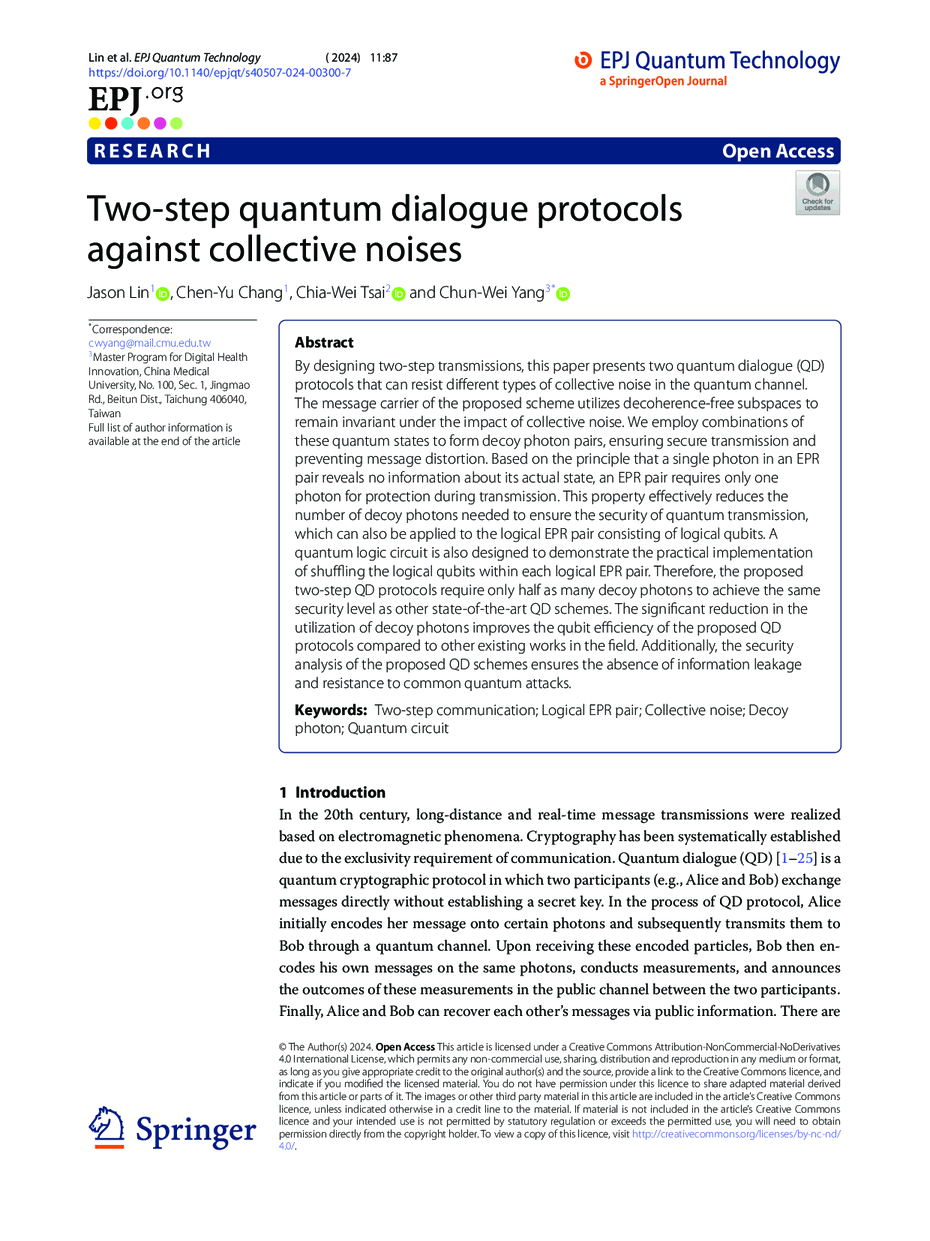https://doi.org/10.1140/epjqt/s40507-024-00300-7
Research
Two-step quantum dialogue protocols against collective noises
1
Department of Computer Science and Engineering, National Chung Hsing University, No. 145, Xingda Rd., South District, 40227, Taichung, Taiwan
2
Department of Computer Science and Information Engineering, National Taichung University of Science and Technology, No. 129, Sec. 3, Sanmin Rd., North Dist., 40401, Taichung, Taiwan
3
Master Program for Digital Health Innovation, China Medical University, No. 100, Sec. 1, Jingmao Rd., Beitun Dist., 406040, Taichung, Taiwan
Received:
9
September
2024
Accepted:
10
December
2024
Published online:
19
December
2024
By designing two-step transmissions, this paper presents two quantum dialogue (QD) protocols that can resist different types of collective noise in the quantum channel. The message carrier of the proposed scheme utilizes decoherence-free subspaces to remain invariant under the impact of collective noise. We employ combinations of these quantum states to form decoy photon pairs, ensuring secure transmission and preventing message distortion. Based on the principle that a single photon in an EPR pair reveals no information about its actual state, an EPR pair requires only one photon for protection during transmission. This property effectively reduces the number of decoy photons needed to ensure the security of quantum transmission, which can also be applied to the logical EPR pair consisting of logical qubits. A quantum logic circuit is also designed to demonstrate the practical implementation of shuffling the logical qubits within each logical EPR pair. Therefore, the proposed two-step QD protocols require only half as many decoy photons to achieve the same security level as other state-of-the-art QD schemes. The significant reduction in the utilization of decoy photons improves the qubit efficiency of the proposed QD protocols compared to other existing works in the field. Additionally, the security analysis of the proposed QD schemes ensures the absence of information leakage and resistance to common quantum attacks.
Key words: Two-step communication / Logical EPR pair / Collective noise / Decoy photon / Quantum circuit
© The Author(s) 2024
 Open Access This article is licensed under a Creative Commons Attribution-NonCommercial-NoDerivatives 4.0 International License, which permits any non-commercial use, sharing, distribution and reproduction in any medium or format, as long as you give appropriate credit to the original author(s) and the source, provide a link to the Creative Commons licence, and indicate if you modified the licensed material. You do not have permission under this licence to share adapted material derived from this article or parts of it. The images or other third party material in this article are included in the article’s Creative Commons licence, unless indicated otherwise in a credit line to the material. If material is not included in the article’s Creative Commons licence and your intended use is not permitted by statutory regulation or exceeds the permitted use, you will need to obtain permission directly from the copyright holder. To view a copy of this licence, visit http://creativecommons.org/licenses/by-nc-nd/4.0/.
Open Access This article is licensed under a Creative Commons Attribution-NonCommercial-NoDerivatives 4.0 International License, which permits any non-commercial use, sharing, distribution and reproduction in any medium or format, as long as you give appropriate credit to the original author(s) and the source, provide a link to the Creative Commons licence, and indicate if you modified the licensed material. You do not have permission under this licence to share adapted material derived from this article or parts of it. The images or other third party material in this article are included in the article’s Creative Commons licence, unless indicated otherwise in a credit line to the material. If material is not included in the article’s Creative Commons licence and your intended use is not permitted by statutory regulation or exceeds the permitted use, you will need to obtain permission directly from the copyright holder. To view a copy of this licence, visit http://creativecommons.org/licenses/by-nc-nd/4.0/.





